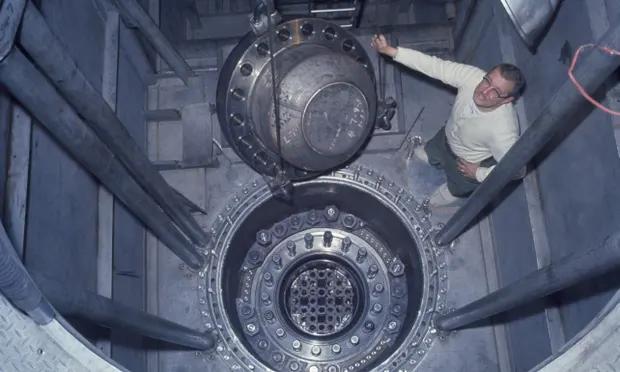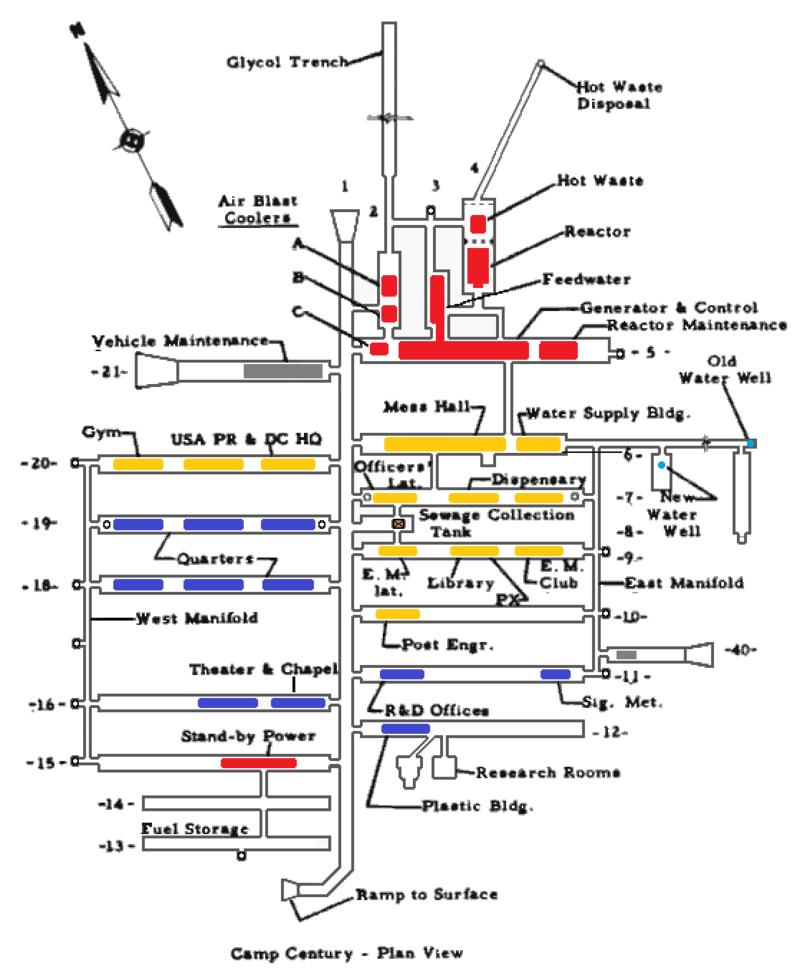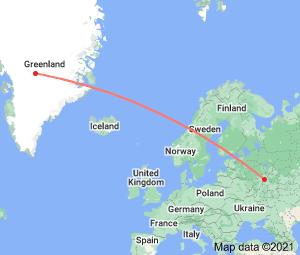Recent conversations about small modular reactors reminded me about the US government’s history of leaving and losing nuclear reactors in various places, during the cold war. To be fair, the Soviets lost a few, too. And, even recently – one aspect of the Russian submarine Kursk that sunk in 2000 [wik] that didn’t get a lot of air-play was the fact that a nuclear reactor and several nuclear warheads sank with it. That must have made recovering the wreck interesting, and I’m sure that NATO intelligence was skipping about with glee at a chance to literally dissect a Russian ballistic missile sub. I wonder how many times the Soviets got to perform similar dissections on US gear?
Let me slightly redirect the topic, though; consider Project Iceworm and Camp Century, and what they really mean. I’d heard about Camp Century back in the 90s but never pieced together the implications; we’ll get to those but first some recap. Project Iceworm was to construct a massive (and I do mean “massive”) under-ice fortress up in Greenland, with some 1800 miles of tunnels. That sounds crazy – it’s a not very hospitable environment to construct in.

Camp Century’s nuclear reactor, 1962
I suspect that the idea of building under ice came out of WWII experiments with ice-structures, like the pycrete (ice and sawdust) aircraft carrier Project Habakkuk [wik] – it turned out that ice is really hard to destroy: it doesn’t burn well and it takes a huge amount of energy to melt. It withstands shock well. It’s almost as if, when Kubrick was writing Doctor Strangelove his whole bit about the “mineshaft gap” was based on information that there were bolt-holes in the Greenland ice that could potentially survive a nuclear war. And. of course, it had its own little nuclear reactor to power it.

One wonders about the wisdom of putting the reactor at the TOP of the structure
All of this was done supposedly without the government of Denmark’s knowledge – they were told that the US was doing some research, not building a nuclear base. I say “supposedly” because it doesn’t seem credible that anyone would not check up on what the Americans were doing. Everyone knows those guys are always sneaking around lying about what they’re up to. It beggars my imagination that the Danes would think a simple research station would be so huge and need a nuclear reactor, etc.
That picture is the sanitized one – that’s just the official main base (which never got fully built) What’s omitted are the silos. Silos for the nuclear warhead-carrying missiles, that were the real reason the camp was being built.
As the wikipedia page delicately puts it:
The missiles were never fielded and necessary consent from the Danish Government to do so was never broached.
Or, “since we never did that violate your trust as we had planned to, we don’t need to apologize.”
Construction on the camp and the sub-glacial nuclear reactor began without explicit permission from the government of Denmark, leading to a political dilemma for Prime Minister H. C. Hansen.
[“and now for a Massage from the Swedish Prime Minister.”] The further construction of the camp was halted because it turns out that ice is strong but not stable – the place was moving around. At the time, in the 1960s, the ice-pack on Greenland was still growing so one problem was that the base kept getting deeper and deeper. Now, it’s a lot more shallow. But having the base get deeper is a problem because the missile silos are threatened. I assume shoveling the snow off a silo door is no trivial task.
 Now, it gets ugly. The presumptive reason for building such a base is that it could potentially survive a nuclear war. For one thing, who’s going to speculatively nuke Greenland? As long as the base stayed secret, it would not be a target. That’s all the official story, anyhow. What I think was really going on is a lot more grim. Greenland is half the distance to Moscow than the East Coast of the US – a bunch of missiles launched from Greenland are going to show up, surprise!, in half the time. Project Iceworm wasn’t intended as a base to survive a nuclear war, it was intended as an outpost from which to start a nuclear war and the to survive the aftermath. This was the 60s, remember – around the same time as the US was positioning medium-range ballistic missiles in Italy and Turkey, too, basically surrounding the USSR with first-strike weapons that could obliterate the country before they had a chance to get a counter-strike into the air.
Now, it gets ugly. The presumptive reason for building such a base is that it could potentially survive a nuclear war. For one thing, who’s going to speculatively nuke Greenland? As long as the base stayed secret, it would not be a target. That’s all the official story, anyhow. What I think was really going on is a lot more grim. Greenland is half the distance to Moscow than the East Coast of the US – a bunch of missiles launched from Greenland are going to show up, surprise!, in half the time. Project Iceworm wasn’t intended as a base to survive a nuclear war, it was intended as an outpost from which to start a nuclear war and the to survive the aftermath. This was the 60s, remember – around the same time as the US was positioning medium-range ballistic missiles in Italy and Turkey, too, basically surrounding the USSR with first-strike weapons that could obliterate the country before they had a chance to get a counter-strike into the air.
If what you’re trying to do is deter the other guys from launching a nuclear strike, you need a few missiles that are distant and deeply buried, hard to hit, which can be brought out and launched in response to an attack. What you don’t need is a bunch of weapons that are designed and positioned for launching a decapitation strike. The Cuban Missile Crisis, which caused a massive temper-tantrum from the US, was doing to the US what the US was doing to everyone else – positioning missiles where they could quickly reach Washington, DC. Basically, the Soviets were going, “OK let’s see how you like a taste of your own medicine” and the US really didn’t like the taste at all.
The US was constantly planning and positioning itself to win a nuclear war, and it still is. All that talk about “deterrence” is window-dressing and anyone who takes a close look at what the US has been doing since the 1950s cannot possibly mistake its policy as peaceful. The surprise, to me, is that the US has been in a position to win a nuclear war against various opponents several times since the weapons were developed and has managed to refrain from doing so. Given how trigger-happy the US is when it comes to dropping conventional high explosives on peasants, that’s the real surprise.

@Marcus:
That appears to be the northeast corner, not the top.
Oops yes I figured that out and forgot to remove that quip from the posting.
@1- I had the same ‘orientation problem.’ until I got to the “bottom” and saw “ramp to surface.”
I suppose by putting the reactor near the mess hall, they could use some of the waste heat for cooking.
Agreed. Denmark has long had an ambiguous policy of looking the other way. Denmark is politically very anti-nuclear, so our politicians couldn’t officially agree without pissing people off. So they just unofficially agreed. That’s what happened at the Thule base or with those warheads stationed in Germany, ready to be shipped across the border at a moments notice.
Marcus @ #0, James Hammond @ #1:
One wonders about the wisdom of putting the reactor at the TOP of the structure.
The word ‘plan’ tells you it’s viewed from above, but the numbers confused me for a minute. Negative numbers suggest depth levels, but the sequence on the left goes the opposite way from the sequence on the right. Also, there are the 1 2 3 4 with no minus signs or dashes at the top, which clearly continue with the 5 6 and so on clockwise. Those are actually “— number —”, not negative numbers, and they’re keys to vertical section views of the respective areas. (The typewriter does not have a vertical dash or bar for the first four cross-section labels.)
Yes, yet another nuke dream from the sixties.
Forgetting about the legality of the thing for a moment (it’s nice as it is, why spoil it by making it legal?), I would say it was typical for the time, a Zeitgeist kind of thing.
Need a wide harbor in Alaska? Dig it with five H-bombs in sequence – this one dreamt up by E.Teller.
Want to go to space? Von Braun drew plans for a two-person space plane, powered by a nice mini-reactor placed in the nose.
I just found some old bound copies of the magazine “Nucleonics”, and its 1963 special issue on nuclear-powered space exploration. Ye gawds, the plans that were hatched. Nukes taking off everywhere, with mention of a Saturn expedition (!).
So really, everyone was thinking about that stuff back then, it was to be our bright future… IF ONLY that awkward Mutually Assured Destruction thingy could be avoided.
US Navy sacks commanding officers of crashed submarine
I wonder how much Project Habakkuk inspired and influenced this old SF novel which put that into space :
https://www.fantasticfiction.com/r/walt-richmond/gallaghers-glacier.htm
Anyone else read / remember that?
I’m presuming here that the Greenland “base” / missile site did NOT actually stay secret from the Soviet Union and they found out about it. I’d say that it’s discovery was always predictable given its scope and the times and capbilities of the USA & USSR.
Do we know for sure whether that is the case or not?
Off topic, apologies but since there’s no open thread (yes that’s a hint) & just incase you haven’t seen it – your thougts on this :
https://freethoughtblogs.com/oceanoxia/2021/11/03/the-past-is-present-fbi-bias-against-progressive-politics-continues-to-undermine-the-pretense-of-democracy-in-the-u-s/
please Marcus Ranum? . :
StevoR@#11:
I’m presuming here that the Greenland “base” / missile site did NOT actually stay secret from the Soviet Union and they found out about it. I’d say that it’s discovery was always predictable given its scope and the times and capbilities of the USA & USSR.
Do we know for sure whether that is the case or not?
I don’t believe I have seen anything about whether the Soviets knew about the base. Like you, I’m comfortable assuming that they did. It was a big enough project and the US is not very good at keeping secrets. Probably the Swedes knew about it to, and were warned to nudge-nudge-wink-wink if the plan for nuclear missiles ever came out.
It’s an interesting strategy, really – use Greenland as a missile sponge (instead of, say, Ohio or Minnesota) to take a good nuking in the event of a war.
My view is pretty dark: I think the only reason we’re still alive today is because our leaders were afraid that they wouldn’t win by a large enough margin.
since there’s no open thread (yes that’s a hint)
Oh! It never occurred to me to set one up. Will do.
Thanks. Much appreciated.